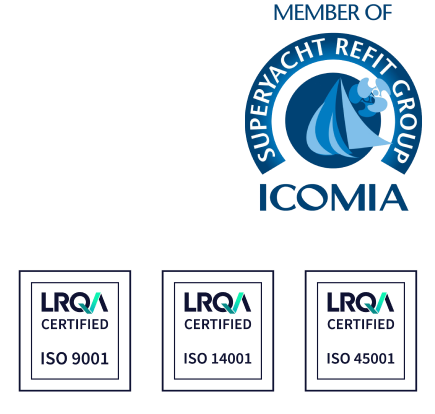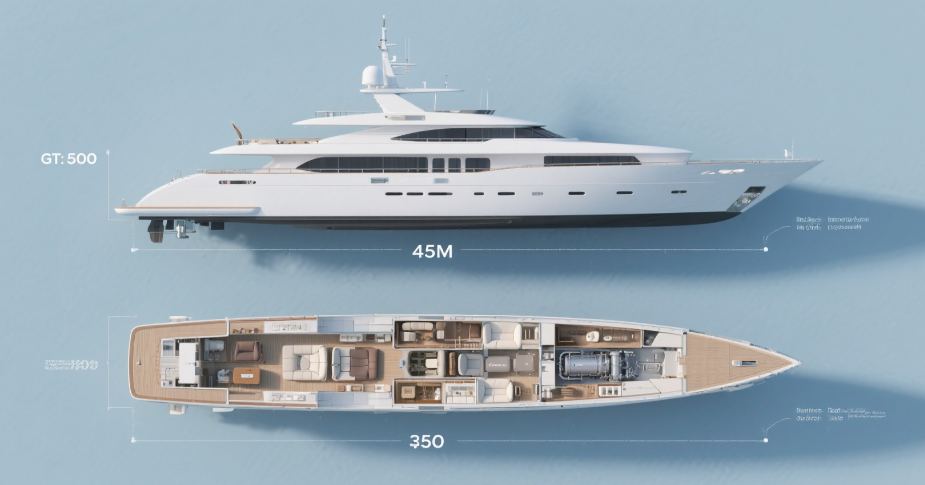If you’ve ever looked at a yacht spec sheet and seen a number labeled “GT” or “Gross Tonnage,” you might assume it refers to how much the yacht weighs. That’s a common mistake—and one that can lead to confusion when comparing vessels or trying to understand maritime regulations. In reality, Gross Tonnage is not about weight at all, and understanding what it really means is essential whether you’re a captain, a crew member, a yacht manager, or just starting out in the industry.
Why Gross Tonnage Matters
Gross Tonnage is one of the most important measurements in the yachting world, especially when it comes to things like registration, compliance, manning requirements, port fees, and even refit considerations. It affects how a vessel is classified, taxed, and managed. For newcomers, it might seem like just another number, but for professionals, it plays a significant role in decision-making throughout a yacht’s lifecycle.
So, What Exactly is Gross Tonnage?
Gross Tonnage (GT) is a measure of the internal volume of a vessel, not its weight. It is calculated using a formula that considers the total enclosed spaces of the yacht, from the hull to the superstructure, and includes areas like cabins, salons, engine rooms, and technical spaces.
Unlike displacement, which refers to how much water a yacht displaces (and thus is related to weight), GT is purely a volumetric measurement. It gives a sense of how much usable or functional space is inside the vessel.
For example:
-
A 45-meter yacht with a wide beam and tall decks might have a GT of 500.
-
Another 45-meter yacht with a narrower design and fewer interior spaces could have a GT of 350.
Same length, very different GTs.
GT vs Other Tonnage Terms
This is where things often get tangled. Here’s how Gross Tonnage differs from other similar-sounding terms:
-
Displacement Tonnage is the actual weight of the yacht, measured in metric tons. It’s related to buoyancy and stability.
-
Net Tonnage (NT) is derived from GT but subtracts non-revenue spaces. It’s mostly used for commercial vessels.
-
Deadweight Tonnage (DWT) is used in shipping and refers to how much cargo, fuel, and supplies a ship can carry.
In yachting, Gross Tonnage is the standard reference when discussing a yacht’s size for operational and regulatory purposes.
Why it’s Important in Yachting
Gross Tonnage affects a wide range of real-world decisions and responsibilities. For example:
-
Classification and Flag Requirements: Many flag states and class societies set rules that change based on GT thresholds, such as over 500 GT.
-
Crew Certifications: Manning regulations are often tied to GT. A yacht over 500 GT may require different qualifications than one below it.
-
Port Fees and Docking Costs: Marinas and harbors often charge based on GT because it reflects the vessel’s volume and space usage.
-
Refit Projects: Internal volume influences everything from design modifications to system upgrades and space planning.
So while it might seem like a technical figure, GT actually has ripple effects throughout yacht operations, design, and maintenance.
How is Gross Tonnage Calculated?
The actual formula used to calculate GT is set by the International Maritime Organization (IMO) and goes like this:
GT = K × V
-
V is the total volume of all enclosed spaces in cubic meters.
-
K is a constant derived from a logarithmic formula depending on the volume.
While you won’t need to calculate it manually, it’s useful to know that GT grows exponentially with volume, which is why small increases in interior space can bump up a yacht’s tonnage significantly.
Why Should You Care?
Whether you’re managing compliance, planning a refit, or simply comparing yachts, understanding Gross Tonnage helps you make better-informed decisions. It influences everything from technical specs to operational costs and legal requirements. And now that you know it has nothing to do with weight, you’ll never look at GT the same way again.
FAQ: Gross Tonnage (GT) in Yachting
Why do two yachts with the same length have very different GT values?
Gross Tonnage is based on internal volume, not length. A yacht with more enclosed areas, a wider beam, or taller deck spaces will have a higher GT even if its length is identical to another vessel.
Does increasing GT always mean more luxury or better features?
Not necessarily. Higher GT means more space to work with, but how that space is used varies. Some yachts focus on open layouts or large crew areas, while others prioritize guest cabins and amenities.
Is GT something owners should worry about during a refit?
Yes. Structural changes that increase enclosed volume can raise GT, which might trigger new regulatory requirements or change crew certification needs. It’s something to consider during major interior work or extensions.
Can GT affect how many crew members are needed?
It can. Manning regulations and minimum crew certifications often change at GT thresholds like 500 or 3000. A higher GT yacht may legally require more crew or differently qualified officers.
How is GT verified or measured?
GT is calculated during the vessel’s tonnage certification process, usually done by a naval architect and verified by classification societies or flag authorities. It’s part of a yacht’s official documentation.
Is GT relevant for charter yachts too?
Absolutely. Some charter licenses or commercial operation rules depend on GT. It can also impact marina fees, pilotage, and access to certain ports depending on regional rules.
Can GT be reduced or changed after a yacht is built?
Yes, but it requires structural modifications, such as removing enclosed spaces or reconfiguring internal volume. It’s not simple, and it should be evaluated carefully if regulatory thresholds are a concern.
Why is GT so important around the 500 mark?
The 500 GT threshold is significant because many international maritime rules kick in at that level. Yachts above 500 GT face stricter safety, environmental, and operational regulations.









